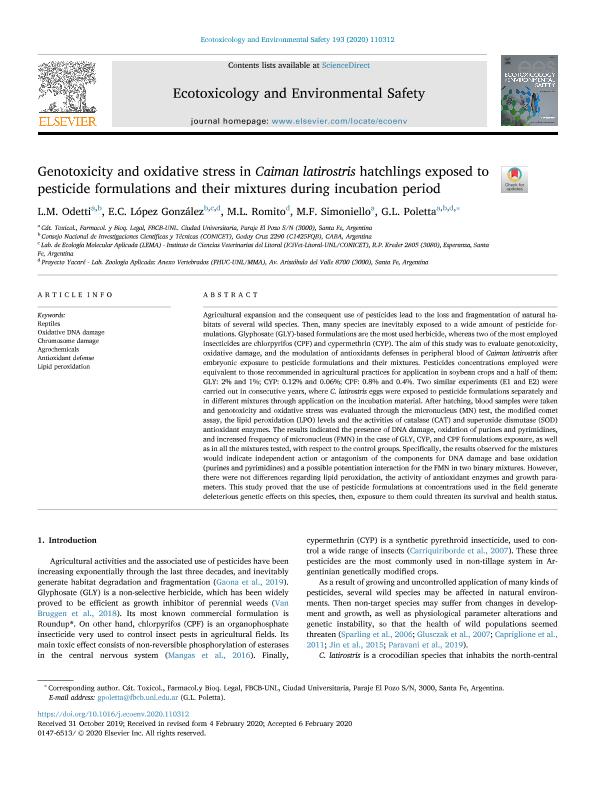Mostrar el registro sencillo del ítem
dc.contributor.author
Odetti, Lucia Magdalena

dc.contributor.author
López González, Evelyn Cecilia

dc.contributor.author
Romito, María Laura

dc.contributor.author
Simoniello, Maria Fernanda

dc.contributor.author
Poletta, Gisela Laura

dc.date.available
2021-11-02T11:52:50Z
dc.date.issued
2020-04
dc.identifier.citation
Odetti, Lucia Magdalena; López González, Evelyn Cecilia; Romito, María Laura; Simoniello, Maria Fernanda; Poletta, Gisela Laura; Genotoxicity and oxidative stress in Caiman latirostris hatchlings exposed to pesticide formulations and their mixtures during incubation period; Academic Press Inc Elsevier Science; Ecotoxicology and Environmental Safety; 193; 4-2020; 1-10
dc.identifier.issn
0147-6513
dc.identifier.uri
http://hdl.handle.net/11336/145690
dc.description.abstract
Agricultural expansion and the consequent use of pesticides lead to the loss and fragmentation of natural habitats of several wild species. Then, many species are inevitably exposed to a wide amount of pesticide formulations. Glyphosate (GLY)-based formulations are the most used herbicide, whereas two of the most employed insecticides are chlorpyrifos (CPF) and cypermethrin (CYP). The aim of this study was to evaluate genotoxicity, oxidative damage, and the modulation of antioxidants defenses in peripheral blood of Caiman latirostris after embryonic exposure to pesticide formulations and their mixtures. Pesticides concentrations employed were equivalent to those recommended in agricultural practices for application in soybean crops and a half of them: GLY: 2% and 1%; CYP: 0.12% and 0.06%; CPF: 0.8% and 0.4%. Two similar experiments (E1 and E2) were carried out in consecutive years, where C. latirostris eggs were exposed to pesticide formulations separately and in different mixtures through application on the incubation material. After hatching, blood samples were taken and genotoxicity and oxidative stress was evaluated through the micronucleus (MN) test, the modified comet assay, the lipid peroxidation (LPO) levels and the activities of catalase (CAT) and superoxide dismutase (SOD) antioxidant enzymes. The results indicated the presence of DNA damage, oxidation of purines and pyrimidines, and increased frequency of micronucleus (FMN) in the case of GLY, CYP, and CPF formulations exposure, as well as in all the mixtures tested, with respect to the control groups. Specifically, the results observed for the mixtures would indicate independent action or antagonism of the components for DNA damage and base oxidation (purines and pyrimidines) and a possible potentiation interaction for the FMN in two binary mixtures. However, there were not differences regarding lipid peroxidation, the activity of antioxidant enzymes and growth parameters. This study proved that the use of pesticide formulations at concentrations used in the field generate deleterious genetic effects on this species, then, exposure to them could threaten its survival and health status.
dc.format
application/pdf
dc.language.iso
eng
dc.publisher
Academic Press Inc Elsevier Science

dc.rights
info:eu-repo/semantics/openAccess
dc.rights.uri
https://creativecommons.org/licenses/by-nc-nd/2.5/ar/
dc.subject
AGROCHEMICALS
dc.subject
ANTIOXIDANT DEFENSE
dc.subject
CHROMOSOME DAMAGE
dc.subject
LIPID PEROXIDATION
dc.subject
OXIDATIVE DNA DAMAGE
dc.subject
REPTILES
dc.subject.classification
Otras Ciencias Biológicas

dc.subject.classification
Ciencias Biológicas

dc.subject.classification
CIENCIAS NATURALES Y EXACTAS

dc.title
Genotoxicity and oxidative stress in Caiman latirostris hatchlings exposed to pesticide formulations and their mixtures during incubation period
dc.type
info:eu-repo/semantics/article
dc.type
info:ar-repo/semantics/artículo
dc.type
info:eu-repo/semantics/publishedVersion
dc.date.updated
2021-04-28T20:42:34Z
dc.journal.volume
193
dc.journal.pagination
1-10
dc.journal.pais
Estados Unidos

dc.description.fil
Fil: Odetti, Lucia Magdalena. Universidad Nacional del Litoral. Facultad de Bioquímica y Ciencias Biológicas. Cátedra de Toxicología y Bioquímica Legal; Argentina. Consejo Nacional de Investigaciones Científicas y Técnicas; Argentina
dc.description.fil
Fil: López González, Evelyn Cecilia. Consejo Nacional de Investigaciones Científicas y Técnicas. Centro Científico Tecnológico Conicet - Santa Fe. Instituto de Ciencias Veterinarias del Litoral. Universidad Nacional del Litoral. Facultad de Ciencias Veterinarias. Instituto de Ciencias Veterinarias del Litoral; Argentina
dc.description.fil
Fil: Romito, María Laura. Universidad Nacional del Litoral. Facultad de Bioquímica y Ciencias Biológicas. Cátedra de Toxicología y Bioquímica Legal; Argentina
dc.description.fil
Fil: Simoniello, Maria Fernanda. Universidad Nacional del Litoral. Facultad de Bioquímica y Ciencias Biológicas. Cátedra de Toxicología y Bioquímica Legal; Argentina. Consejo Nacional de Investigaciones Científicas y Técnicas; Argentina
dc.description.fil
Fil: Poletta, Gisela Laura. Consejo Nacional de Investigaciones Científicas y Técnicas; Argentina. Universidad Nacional del Litoral. Facultad de Bioquímica y Ciencias Biológicas. Cátedra de Toxicología y Bioquímica Legal; Argentina
dc.journal.title
Ecotoxicology and Environmental Safety

dc.relation.alternativeid
info:eu-repo/semantics/altIdentifier/doi/http://dx.doi.org/10.1016/j.ecoenv.2020.110312
dc.relation.alternativeid
info:eu-repo/semantics/altIdentifier/url/https://www.sciencedirect.com/science/article/pii/S0147651320301512
Archivos asociados
